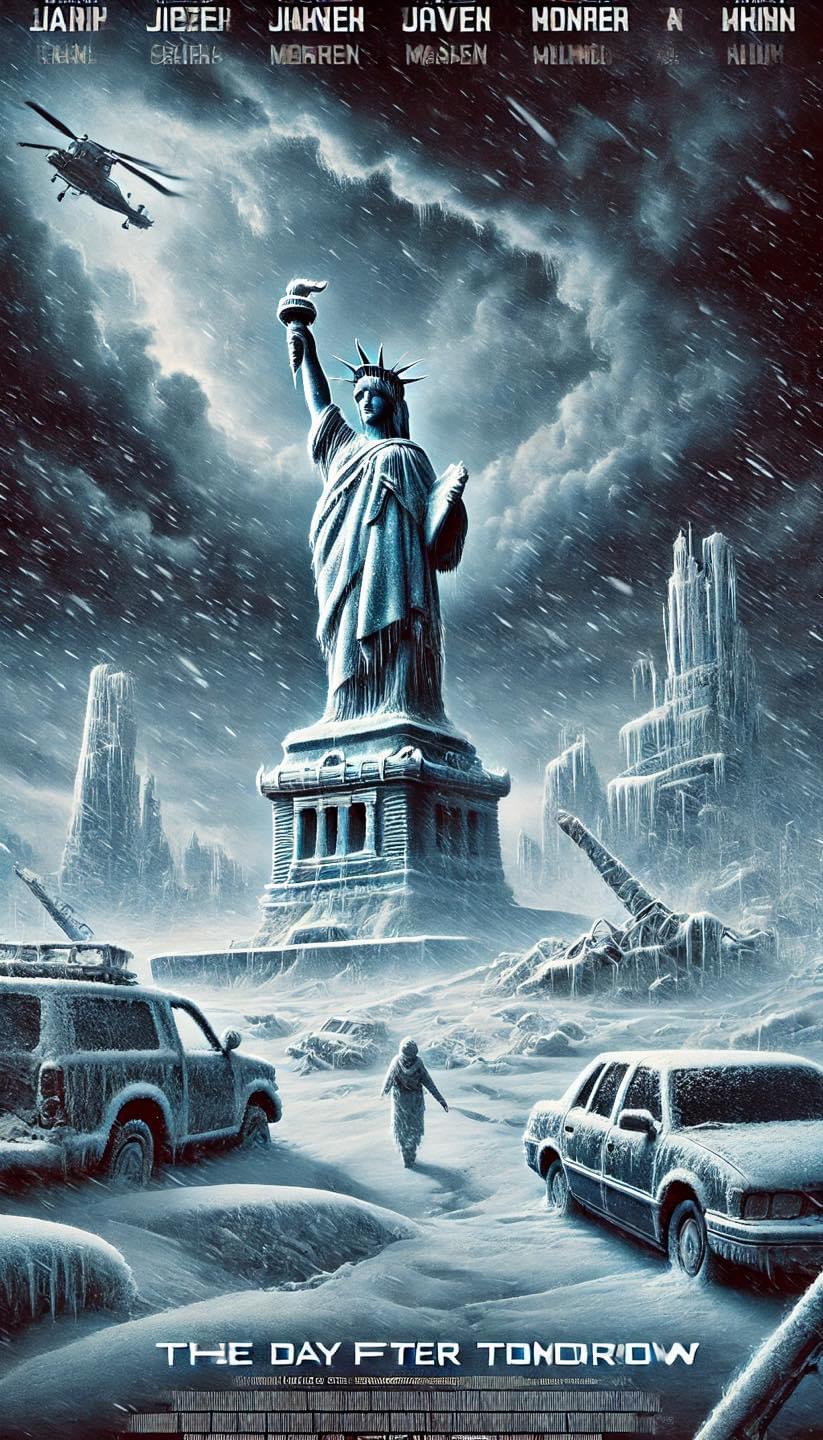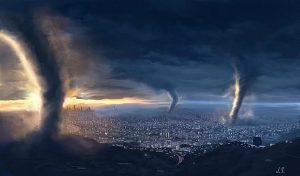The Day After Tomorrow (2004)

The Day After Tomorrow (2004), directed by Roland Emmerich, is a thrilling yet scientifically exaggerated disaster film that explores the devastating consequences of rapid climate change. With an emphasis on visual spectacle, the film centers on the abrupt and catastrophic effects of global warming, which leads to a series of extreme weather events culminating in a new ice age. Featuring an ensemble cast led by Dennis Quaid and Jake Gyllenhaal, The Day After Tomorrow blends large-scale action sequences with a personal story about survival and sacrifice. While the film is celebrated for its groundbreaking visual effects, it has been criticized for oversimplifying and sensationalizing the science of climate change. Despite these critiques, the film resonates as a cautionary tale about environmental negligence.
Suggested videos for you:
Plot Summary
The story begins with paleoclimatologist Jack Hall (Dennis Quaid) delivering a presentation at a U.N. climate conference, where he warns world leaders about the dangerous effects of global warming. Hall explains that the melting of the polar ice caps could disrupt the North Atlantic Ocean circulation, leading to a sudden and severe climate shift. His warnings, however, are dismissed by skeptical politicians, particularly the U.S. Vice President, Raymond Becker (Kenneth Welsh), who refuses to take immediate action to address the threat.
Not long after, Hall’s dire predictions come true. A series of unprecedented and extreme weather events start occurring across the globe: Tokyo is struck by massive hailstones, Los Angeles is ravaged by tornadoes, and New Delhi experiences record snowfall. These anomalies are revealed to be the first signs of a massive disruption in global climate systems. As the superstorm intensifies, it creates three enormous hurricane-like systems in the Northern Hemisphere, which rapidly begin to freeze everything in their path. This global climate catastrophe results in a new ice age descending upon much of the northern hemisphere.
Amidst the chaos, Jack’s son, Sam Hall (Jake Gyllenhaal), is trapped in New York City after traveling there for an academic competition. As the superstorm approaches, Sam and a group of survivors, including his friends Laura (Emmy Rossum) and Brian (Arjay Smith), take refuge in the New York Public Library. As temperatures plummet, Sam and the others face a desperate struggle for survival, relying on their wits and limited resources to keep warm and avoid the freezing temperatures outside.
Meanwhile, Jack, motivated by his paternal instincts and guilt over not spending enough time with his son, embarks on a perilous journey to New York to rescue Sam. Joined by his colleagues, Frank (Jay O. Sanders) and Jason (Dash Mihok), Jack makes his way through the frozen wasteland, battling the elements and his own physical limits. As the storm worsens, the film builds toward a dramatic climax where both Sam’s group and Jack must confront the overwhelming power of nature and make life-or-death decisions.
Themes and Symbolism
The Day After Tomorrow primarily revolves around the theme of environmental destruction and humanity’s failure to heed warnings about climate change. The film serves as a cautionary tale, illustrating the potential consequences of ignoring scientific evidence and failing to take proactive measures to mitigate environmental harm. Through the character of Jack Hall, the film conveys the message that science should be taken seriously and that the consequences of inaction can be catastrophic. The disastrous weather events in the film represent the wrath of nature, punishing humanity for its disregard for the environment.
The film also touches on themes of sacrifice and survival, particularly in the father-son relationship between Jack and Sam. Jack’s journey to save his son serves as an emotional throughline, providing a personal dimension to the global disaster unfolding around them. Jack’s determination to rescue Sam, despite the dangers posed by the extreme weather, is a testament to parental love and the lengths a parent will go to protect their child. The survival storylines of Sam and his group also highlight themes of resilience and cooperation in the face of overwhelming odds.
The film subtly explores the socioeconomic implications of environmental disasters, particularly in a key scene where Americans are seen fleeing to Mexico to escape the extreme cold, reversing the typical immigration narrative. This ironic reversal highlights the idea that environmental catastrophes do not discriminate and that the consequences of climate change will affect everyone, regardless of nationality or social status.
Visual Effects and Action Sequences
The film’s most impressive and widely praised feature is its use of groundbreaking visual effects to depict large-scale natural disasters. From the iconic image of tornadoes ripping through downtown Los Angeles to the stunning scenes of New York City being submerged by a tidal wave and then frozen in a matter of hours, the movie excels in its portrayal of nature’s destructive power. The visual effects team, led by Karen Goulekas and Neil Corbould, achieved a level of realism that was rarely seen in disaster films up to that point, making the film a visual spectacle.
One of the film’s most memorable sequences involves a colossal tidal wave that floods Manhattan, a precursor to the freezing storm that would soon engulf the city. The dramatic scene of Sam and his friends outrunning the wave and seeking shelter in the New York Public Library encapsulates the film’s ability to deliver heart-pounding, adrenaline-fueled action.
The storm sequences, particularly those showing the rapid freezing of entire cities, are visually stunning and evoke a sense of awe and terror. The frozen landscapes that emerge in the aftermath of the superstorm are depicted in stark, chilling beauty, with landmarks like the Statue of Liberty and the Empire State Building buried in snow and ice. The use of CGI is integral to these sequences, creating a sense of realism that enhances the film’s emotional impact.
Scientific Inaccuracies
While The Day After Tomorrow is visually impressive and carries an urgent environmental message, it has been criticized for its numerous scientific inaccuracies. Climate scientists have pointed out that the film’s premise—global warming causing an instantaneous ice age through the disruption of the North Atlantic Ocean circulation—is highly exaggerated and unrealistic. While there is some scientific basis for concerns about the slowing of ocean currents due to melting polar ice, the sudden and extreme weather events depicted in the film are not consistent with current scientific understanding of how climate change would unfold.
Additionally, the film compresses what would likely take decades or centuries of gradual climate shifts into a matter of days, turning a complex process into a dramatic but scientifically implausible series of events. The extreme freezing and superstorm conditions, while visually striking, do not align with the ways in which the Earth’s climate system functions. The film’s portrayal of global warming as an immediate, apocalyptic event oversimplifies the more gradual and complex realities of climate change, leading to criticism that it distorts public understanding of the issue.
Performances and Character Development
The performances in The Day After Tomorrow are solid, though they often take a backseat to the film’s spectacle. Dennis Quaid delivers a credible performance as Jack Hall, playing the dedicated scientist and father with conviction. While his character is somewhat one-dimensional, Quaid brings a sense of gravitas to the role, particularly in the scenes where he battles the elements to reach his son.
Jake Gyllenhaal, as Sam, gives a strong performance as a resourceful and determined teenager trying to survive in extreme conditions. His chemistry with Emmy Rossum, who plays his love interest, Laura, adds a touch of human warmth to the otherwise cold and chaotic world of the film. However, like most disaster films, character development is secondary to the action, and many of the supporting characters are given little depth.
The film also touches on political and social themes, particularly through the character of Vice President Becker, who represents the government’s reluctance to take climate change seriously. His eventual realization of the gravity of the situation serves as a critique of political inaction in the face of environmental crises.
Reception and Legacy
The Day After Tomorrow received mixed reviews from critics but was a commercial success, grossing over $550 million worldwide. Critics praised the film’s visual effects and thrilling action sequences but criticized its lack of scientific accuracy and formulaic storytelling. Despite the critiques, the film has remained a popular entry in the disaster genre, largely due to its engaging premise and spectacular visual set pieces.
The film also had an impact on the public discourse surrounding climate change, raising awareness about environmental issues, even if it did so through a sensationalized lens. Its release sparked debates about the role of Hollywood in educating the public about complex scientific topics and whether entertainment should prioritize accuracy over drama.
Conclusion
The Day After Tomorrow is an entertaining and visually stunning disaster film that delivers on spectacle but falls short in terms of scientific realism. While the film’s depiction of rapid climate change and extreme weather events is exaggerated, it succeeds in conveying the potential dangers of environmental neglect. With its thrilling action sequences, particularly the iconic storm and flood scenes, and its focus on the bond between a father and son, The Day After Tomorrow remains a memorable entry in the disaster genre. Though not without its flaws, it serves as a reminder of the power of nature and the importance of addressing climate change before it’s too late.











